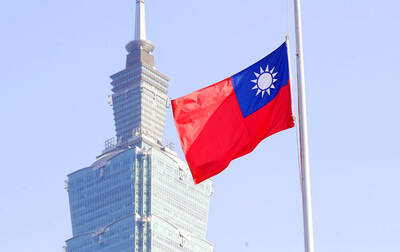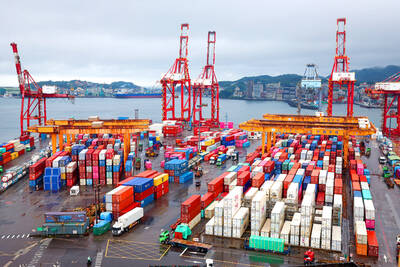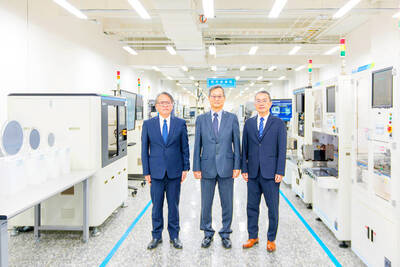A visit by Chinese retailers is intended to help Taiwanese suppliers tap into China’s domestic market rather than place orders, but may still generate billions of NT dollars in business, trade officials from the two sides said yesterday.
Nearly 150 Chinese buyers from 73 enterprises met with Taiwanese fruit, beverage, snack and other food suppliers for one-on-one talks that introduced Taiwanese products to the Chinese.
Wang Chih-kang (王志剛), chairman of the Taiwan External Trade Development Council (TAITRA), the organizer of the two-day event, highlighted the possibility of cooperation between retailers on the two sides of the Strait rather than on the value of possible procurements.
“The potential for contracts for a regular supply of Taiwanese products to Chinese customers is more significant than one-time orders,” Wang told the opening ceremony in Taipei.
Wang’s agency will organize a similar presentation in Tainan tomorrow. A total of 340 Taiwanese suppliers have signed up for the presentations.
Unlike the previous visit last month by Chinese buyers who placed orders for flat panels and other electronic products, Wang said this delegation consists of executives from department store chains, supermarkets and logistics providers.
They represent Beijing Hualian Group (北京華聯集團), Beijing Wangfujing Department Store (北京王府井百貨), Hefei Department Store Group Co (合肥百貨) and Wuhan Zhongbai Group Co (武漢中百集團), Wang said.
In addition to long-term cooperation, the Chinese buyers are expected to place orders for NT$6.6 billion (US$200 million) in locally made food products, Wang said.
Hefei group yesterday ordered 500,000 yuan (US$73,000) in soft drinks from HeySong Corp (黑松).
Cheng Jun (程軍), chairman and vice president of Wuhan Zhongbai Chain Warehouse Supermarket Co (武漢中百連鎖倉儲超市), said the four Taiwanese products that have seen the most growth in China are fruit, dry snacks, condiments and beverages.
As Chinese consumers have become more quality selective and health conscious, Cheng said he saw opportunities for Taiwanese producers of organic agricultural products as well as non-processed and unsweetened foods.
“We witnessed 30 percent growth in organic foods last year and expect this trend to continue,” he said. “One of the reasons for my visit is to speak with local organic agriculture companies.”
Despite the economic downturn, China-bound fruit and food soared 123.68 percent in the first half of the year compared with the same period last year, while cookies and grain products jumped 83.21 percent, TAITRA data showed.
Meanwhile, TAITRA plans to open a liaison office in Nanning, the biggest city in China’s Guangxi Province.
The office should open in one or two months now that Guangxi provincial authorities have given it the go-ahead, Wang said.
“A liaison official will be posted at the office to help serve Taiwanese business people seeking to tap the markets in neighboring ASEAN,” he said.
The Nanning office will be the fifth that TAITRA has opened in China this year, following the establishment of similar offices in Nanjing, Wuhan, Guangzhou and Dalian in the first half of the year.
Wang said TAITRA would do its best to help Taiwanese businesses break into the ASEAN market as Taiwan and China prepare to sign an economic cooperation framework agreement (ECFA).
Nanning’s strategic location makes it China’s gateway to the ASEAN market, he said.
If Taiwan and China fail to sign an ECFA, Taiwan’s exports to China and ASEAN member states would suffer a heavy blow because a free-trade bloc composed of ASEAN and China (ASEAN plus one) is expected to be implemented next year, Wang said.

ELECTRONICS BOOST: A predicted surge in exports would likely be driven by ICT products, exports of which have soared 84.7 percent from a year earlier, DBS said DBS Bank Ltd (星展銀行) yesterday raised its GDP growth forecast for Taiwan this year to 4 percent from 3 percent, citing robust demand for artificial intelligence (AI)-related exports and accelerated shipment activity, which are expected to offset potential headwinds from US tariffs. “Our GDP growth forecast for 2025 is revised up to 4 percent from 3 percent to reflect front-loaded exports and strong AI demand,” Singapore-based DBS senior economist Ma Tieying (馬鐵英) said in an online briefing. Taiwan’s second-quarter performance beat expectations, with GDP growth likely surpassing 5 percent, driven by a 34.1 percent year-on-year increase in exports, Ma said, citing government

‘REMARKABLE SHOWING’: The economy likely grew 5 percent in the first half of the year, although it would likely taper off significantly, TIER economist Gordon Sun said The Taiwan Institute of Economic Research (TIER) yesterday raised Taiwan’s GDP growth forecast for this year to 3.02 percent, citing robust export-driven expansion in the first half that is likely to give way to a notable slowdown later in the year as the front-loading of global shipments fades. The revised projection marks an upward adjustment of 0.11 percentage points from April’s estimate, driven by a surge in exports and corporate inventory buildup ahead of possible US tariff hikes, TIER economist Gordon Sun (孫明德) told a news conference in Taipei. Taiwan’s economy likely grew more than 5 percent in the first six months

SMART MANUFACTURING: The company aims to have its production close to the market end, but attracting investment is still a challenge, the firm’s president said Delta Electronics Inc (台達電) yesterday said its long-term global production plan would stay unchanged amid geopolitical and tariff policy uncertainties, citing its diversified global deployment. With operations in Taiwan, Thailand, China, India, Europe and the US, Delta follows a “produce at the market end” strategy and bases its production on customer demand, with major site plans unchanged, Delta president Simon Chang (張訓海) said on the sidelines of a company event yesterday. Thailand would remain Delta’s second headquarters, as stated in its first-quarter earnings conference, with its plant there adopting a full smart manufacturing system, Chang said. Thailand is the firm’s second-largest overseas

SUPPLY RESILIENCE: The extra expense would be worth it, as the US firm is diversifying chip sourcing to avert disruptions similar to the one during the pandemic, the CEO said Advanced Micro Devices Inc (AMD) chief executive officer Lisa Su (蘇姿丰) on Wednesday said that the chips her company gets from supplier Taiwan Semiconductor Manufacturing Co (TSMC, 台積電) would cost more when they are produced in TSMC’s Arizona facilities. Compared with similar parts from factories in Taiwan, the US chips would be “more than 5 percent, but less than 20 percent” in terms of higher costs, she said at an artificial intelligence (AI) event in Washington. AMD expects its first chips from TSMC’s Arizona facilities by the end of the year, Su said. The extra expense is worth it, because the company is